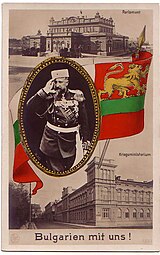

The Armistice with Bulgaria (also known as the Armistice of Thessalonica) was signed on September 29, 1918 at the Bulgaria Armistice Convention in Thessaloniki, Greece, between the Kingdom of Bulgaria and the Allied Powers. The convention followed from a request of the Bulgarian government on September 24, asking for a ceasefire. The armistice effectively ended Bulgaria's participation in World War I on the side of the Central Powers coming into effect at the Bulgarian front at noon on 30 September, and regulated the demobilization and disarmament of the Bulgarian armed forces.
The signatories that participated were French General Franchet d'Esperey on behalf of the Entente and a commission appointed by the Bulgarian Government, composed of General Ivan Lukov (member of the Bulgarian Army HQ), Andrey Lyapchev (Cabinet member), and Simeon Radev (diplomat).
Terms
The terms of the armistice called for the immediate demobilization of all Bulgarian military activities. It ordered the evacuation of Bulgarian-occupied Greek and Serbian territories, placed limits and restrictions to the size of Bulgaria's military employment and required Bulgaria to return military equipment that had been taken from the Greek Fourth Army Corps during the Bulgarian occupation of Eastern Macedonia in 1916. German and Austrian-Hungarian troops had to leave Bulgaria within 4 weeks. Bulgaria and especially Sofia were not to be occupied, but the Allies had the right to temporarily occupy some strategic points and to transfer troops over Bulgarian territory. The French would send troops to Romania and the British and Greeks to European Turkey, at that moment still at war with the Allies.
The document would remain in effect until a final general peace treaty (the Treaty of Neuilly-sur-Seine) was concluded.
References
- (1919) "Bulgaria Armistice Convention, September 29th, 1918". The American Journal of International Law Vol. 13 No.4 Supplement: Official Documents, 402-404.

